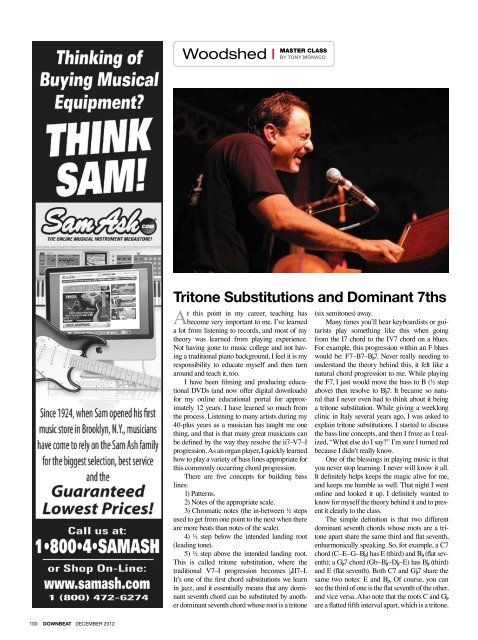Ron Carter Esperanza Spalding - Downbeat
Ron Carter Esperanza Spalding - Downbeat
Ron Carter Esperanza Spalding - Downbeat
You also want an ePaper? Increase the reach of your titles
YUMPU automatically turns print PDFs into web optimized ePapers that Google loves.
Master Class<br />
Woodshed | By tony monaco<br />
Tritone Substitutions and Dominant 7ths<br />
At this point in my career, teaching has<br />
become very important to me. I’ve learned<br />
a lot from listening to records, and most of my<br />
theory was learned from playing experience.<br />
Not having gone to music college and not having<br />
a traditional piano background, I feel it is my<br />
responsibility to educate myself and then turn<br />
around and teach it, too.<br />
I have been filming and producing educational<br />
DVDs (and now offer digital downloads)<br />
for my online educational portal for approximately<br />
12 years. I have learned so much from<br />
the process. Listening to many artists during my<br />
40-plus years as a musician has taught me one<br />
thing, and that is that many great musicians can<br />
be defined by the way they resolve the ii7–V7–I<br />
progression. As an organ player, I quickly learned<br />
how to play a variety of bass lines appropriate for<br />
this commonly occurring chord progression.<br />
There are five concepts for building bass<br />
lines:<br />
1) Patterns.<br />
2) Notes of the appropriate scale.<br />
3) Chromatic notes (the in-between 1/2 steps<br />
used to get from one point to the next when there<br />
are more beats than notes of the scale).<br />
4) 1/2 step below the intended landing root<br />
(leading tone).<br />
5) 1/2 step above the intended landing root.<br />
This is called tritone substitution, where the<br />
traditional V7–I progression becomes bII7–I.<br />
It’s one of the first chord substitutions we learn<br />
in jazz, and it essentially means that any dominant<br />
seventh chord can be substituted by another<br />
dominant seventh chord whose root is a tritone<br />
(six semitones) away.<br />
Many times you’ll hear keyboardists or guitarists<br />
play something like this when going<br />
from the I7 chord to the IV7 chord on a blues.<br />
For example, this progression within an F blues<br />
would be: F7–B7–Bb7. Never really needing to<br />
understand the theory behind this, it felt like a<br />
natural chord progression to me. While playing<br />
the F7, I just would move the bass to B (1/2 step<br />
above) then resolve to Bb7. It became so natural<br />
that I never even had to think about it being<br />
a tritone substitution. While giving a weeklong<br />
clinic in Italy several years ago, I was asked to<br />
explain tritone substitutions. I started to discuss<br />
the bass line concepts, and then I froze as I realized,<br />
“What else do I say?” I’m sure I turned red<br />
because I didn’t really know.<br />
One of the blessings in playing music is that<br />
you never stop learning. I never will know it all.<br />
It definitely helps keeps the magic alive for me,<br />
and keeps me humble as well. That night I went<br />
online and looked it up. I definitely wanted to<br />
know for myself the theory behind it and to present<br />
it clearly to the class.<br />
The simple definition is that two different<br />
dominant seventh chords whose roots are a tritone<br />
apart share the same third and flat seventh,<br />
enharmonically speaking. So, for example, a C7<br />
chord (C–E–G–Bb) has E (third) and Bb (flat seventh);<br />
a Gb7 chord (Gb–Bb–Db–E) has Bb (third)<br />
and E (flat seventh). Both C7 and Gb7 share the<br />
same two notes: E and Bb. Of course, you can<br />
see the third of one is the flat seventh of the other,<br />
and vice versa. Also note that the roots C and Gb<br />
are a flatted fifth interval apart, which is a tritone.<br />
100 DOWNBEAT DECEMBER 2012
















